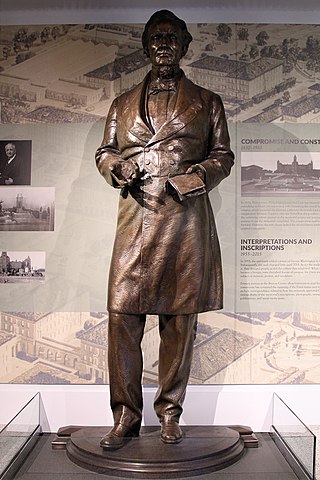
Pompeo Luigi Coppini was an Italian born sculptor who emigrated to the United States. Although his works can be found in Italy, Mexico and a number of U.S. states, the majority of his work can be found in Texas. He is particularly famous for the Alamo Plaza work, Spirit of Sacrifice, a.k.a. The Alamo Cenotaph, as well as numerous statues honoring Texan figures, such as Lawrence Sullivan Ross, the fourth President of Texas A&M University.

The Confederate War Memorial was a 65 foot (20 m)-high monument that pays tribute to soldiers and sailors from Texas who served with the Confederate States of America (CSA) during the American Civil War. The monument was dedicated in 1897, following the laying of its cornerstone the previous year. Originally located in Sullivan Park near downtown Dallas, Texas, United States, the monument was relocated in 1961 to the nearby Pioneer Park Cemetery in the Convention Center District, next to the Dallas Convention Center and Pioneer Plaza.
Confederate monuments and memorials in the United States include public displays and symbols of the Confederate States of America (CSA), Confederate leaders, or Confederate soldiers of the American Civil War. Many monuments and memorials have been or will be removed under great controversy. Part of the commemoration of the American Civil War, these symbols include monuments and statues, flags, holidays and other observances, and the names of schools, roads, parks, bridges, buildings, counties, cities, lakes, dams, military bases, and other public structures. In a December 2018 special report, Smithsonian Magazine stated, "over the past ten years, taxpayers have directed at least $40 million to Confederate monuments—statues, homes, parks, museums, libraries, and cemeteries—and to Confederate heritage organizations."

Frank Teich was a German-born American sculptor, stone carver, and businessman, often referred to as the father of the Texas granite industry.

Jefferson Davis is a statue depicting the American-Confederate politician of the same name by Pompeo Coppini. The sculpture was commissioned in 1919 by George W. Littlefield to be included in the Littlefield Fountain on the campus of the University of Texas at Austin. It was installed on the university's South Mall from 1933 to 2015, when it was relocated to the Dolph Briscoe Center for American History in Austin, Texas.
Woodrow Wilson is a sculpture depicting the American president of the same name by Pompeo Coppini. The sculpture was commissioned in 1919 by George W. Littlefield to be included in the Littlefield Fountain on the campus of the University of Texas at Austin. It was installed on the university's South Mall in Austin, Texas from 1933 until its removal in 2015.

Robert E. Lee is an outdoor bronze sculpture depicting the American general of the same name by Pompeo Coppini. The sculpture was commissioned in 1919 by George W. Littlefield to be included in the Littlefield Fountain on the campus of the University of Texas at Austin. It was installed on the university's South Mall in Austin, Texas from 1933 until its removal in 2017.

James Stephen Hogg is an outdoor sculpture depicting the American lawyer and statesman of the same name by Pompeo Coppini. The sculpture was commissioned in 1919 by George W. Littlefield to be included in the Littlefield Fountain on the campus of the University of Texas at Austin. It was installed on the university's South Mall in Austin, Texas from 1933 until its removal in 2017.

Albert Sidney Johnston is an outdoor sculpture depicting the general of the same name by Pompeo Coppini. The sculpture was commissioned in 1919 by George W. Littlefield to be included in the Littlefield Fountain on the campus of the University of Texas at Austin. It was installed on the university's South Mall in Austin, Texas from 1933 until its removal in 2017.

John H. Reagan is an outdoor sculpture depicting the American politician of the same name by Pompeo Coppini. The sculpture was commissioned in 1919 by George W. Littlefield to be included in the Littlefield Fountain on the campus of the University of Texas at Austin. It was installed on the university's South Mall in Austin, Texas from 1933 until its removal in 2017.

The Confederate Soldiers Monument, also known as the Confederate Dead Monument, is a Confederate memorial installed outside the Texas State Capitol in Austin, Texas. It was erected in 1903. Its sculpture was designed by Pompeo Coppini, and its base was designed by Frank Teich. The sculpture was cast by Roman Bronze Works.

More than 160 monuments and memorials to the Confederate States of America and associated figures have been removed from public spaces in the United States, all but five since 2015. Some have been removed by state and local governments; others have been torn down by protestors.

Jefferson Davis, created by Henry Augustus Lukeman, is a bronze sculpture of Jefferson Davis – a U.S. Senator, U.S. Secretary of War, plantation owner and the only President of the Confederate States of America – commissioned by the U.S. State of Mississippi for inclusion in National Statuary Hall Collection at the United States Capitol's National Statuary Hall, in Washington, D.C. The statue was controversial at the time of its unveiling and there have been multiple efforts to remove it from the Capitol since 2015.

The Hood's Texas Brigade Monument is an outdoor memorial commemorating members of John Bell Hood's Texas Brigade of the Confederate Army installed on the Texas State Capitol grounds in Austin, Texas, United States. The monument was sculptured by Pompeo Coppini and erected in 1910. It is topped by a bronze statue of a Confederate soldier.

Terry's Texas Rangers Monument is an outdoor memorial commemorating Terry's Texas Rangers, a regiment of the Confederate Army installed on the Texas State Capitol grounds in Austin, Texas, United States. The monument was designed by Pompeo Coppini and erected in 1907.

















